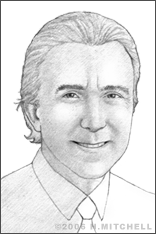Julio Palmaz
A common cause of heart attack and stroke is restricted blood flow caused by atherosclerosis, or clogged arteries. Millions who suffer from this condition have been able to avoid coronary bypass surgery and evade heart attack, stroke and even premature death thanks to a revolutionary, implantable device, the balloon expandable stent, developed in the 1990s by Julio C. Palmaz.
Born on December 13, 1945, in Argentina, Palmaz earned an M.D. from the National University of La Plata, Argentina, in 1971, and spent three years training in radiology at the University of California at Davis’ Martinez Veterans Administration Medical Center before joining San Martin University Hospital in La Plata to practice vascular radiology in 1974. He moved with his family to the United States in 1983 to work as chief of angiography and special procedures in the radiology department at the University of Texas Health and Science Center at San Antonio, (UTHSCSA).
By then, Palmaz had already begun work on what would become one of the most important inventions in modern medicine. In 1978, Palmaz was inspired when he heard a presentation by Andreas Gruentzig, the inventor of balloon angioplasty, at a conference in New Orleans. Gruentzig described his process of opening vessels through a catheter, but he also spoke of the procedure’s limitations, and how vessels could still close up afterwards. Palmaz had an idea then to put a scaffold of sorts inside the vessels, to hold them open and keep them from occluding.
Palmaz wrote up his ideas in a paper, and began working on creating prototypes of an implantable stent, using simple materials such as copper wire and a soldering iron. He modeled the mesh for his stent after metal lathe with a structure of staggered openings, a piece of which he just happened to find lying on his garage floor. The design was just what Palmaz had been seeking – something collapsible that would stand up once inserted and remain rigid.
Palmaz succeeded in creating a model that he was able to test in animals, including pigs and rabbits, with promising results; he also began shopping the device around to medical companies, but the response was lukewarm. However, he persevered.
In 1983, Dr. Stewart Reuter, chief of vascular procedures at UTHSCSA and a mentor to Palmaz, encouraged him to accept a position at the center. Palmaz did so, in part because there he would have access to resources he needed to further his stent development. He eventually succeeded in creating a prototype of a stainless steel, insertable mesh stent that could be expanded once inside the body to hold a blood vessel or artery open and allow blood to flow more freely. He also secured funding from a somewhat unlikely partner: Phil Romano, an entrepreneur who founded restaurant chains such as Fuddruckers and The Macaroni Grill, offered to put up $250,000 in exchange for a stake in the product, which Palmaz began co-developing with Dr. Richard Schatz, a cardiologist at Brooke Army Medical Center.
The trio, calling themselves the Expandable Graft Partnership, patented the stent technology in 1988 and presented it to a variety of large companies. Those firms included Boston Scientific, which passed on the technology, and Johnson & Johnson, which eventually licensed the stent technology for some $10 million plus royalties.
With Johnson & Johnson behind it, and with an additional $100 million invested in its development, the Palmaz stent was approved for use in peripheral arteries in 1991, followed by approval for use in coronary arteries in 1994; Johnson & Johnson quickly captured 90 percent of the market for stents and bought the patent outright from Palmaz, Schatz and Romano in 1998.
Competition naturally followed, with Boston Scientific, Medtronic and Guidant selling their own stents, which resulted in a slew of patent infringement lawsuits. Johnson & Johnson, however, saw its market share fall to less than 5 percent as competitors’ new stent versions offered features cardiologists preferred. An infringement lawsuit lasting over a 12-year period ruled in favor of Johnson and Johnson, declaring that the Palmaz patents have been infringed.
Stent use has become increasingly common, with over 2 million implanted each year around the world, and used not only in coronary and peripheral arteries but also in organs such as the trachea, urethra, bile ducts and colon. Palmaz remained at UTHSCSA where he held the post of chief of angiography and special procedures until 1999. In 2006 he became a tenured professor and chief of cardiovascular and bioprosthetic research there. He also was co-founder of Advanced Bio Prosthetic Surfaces, along with Schatz and Romano, where he continued to work on advanced stent development using nanotechnology, radio frequency identification technology and drug delivery systems.
Palmaz has earned over 20 patents over the course of his career and has been honored with a number of awards including the 2002 International Society of Endovascular Surgery Honor Award for Excellence, the 2003 Presidential Distinguished Scholar Award from the University of Texas San Antonio, an induction into the National Inventors Hall of Fame in 2006, and the National Academy for Inventors in 2013. He also owns and operates Palmaz Vineyards in California’s Napa Valley. He has seen his balloon-expandable stent named twice among IP International Magazine’s "Ten patents that changed the world" list, and his early stent research is part of the Smithsonian Institution’s permanent medical collection.


